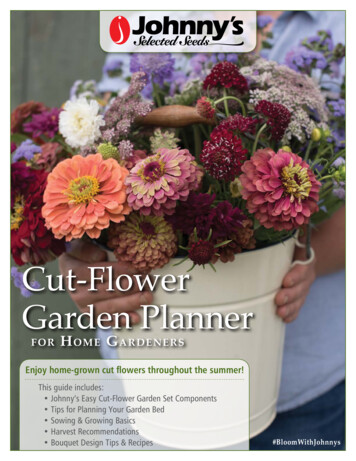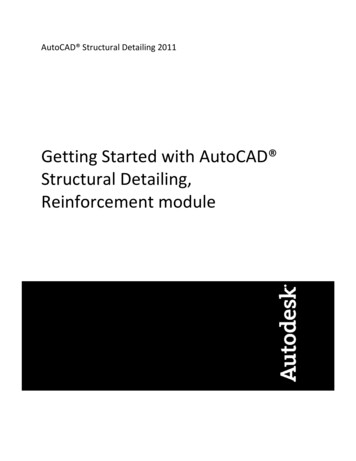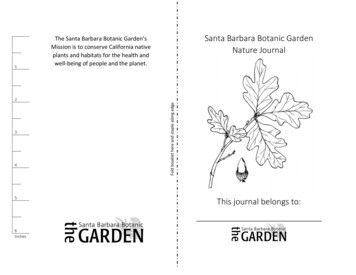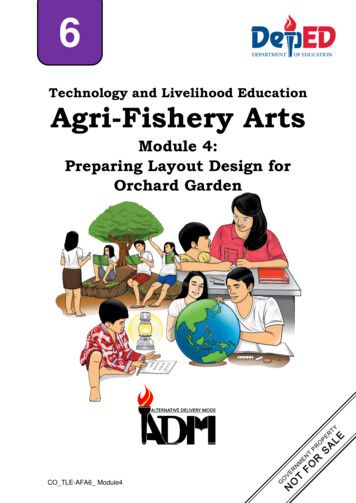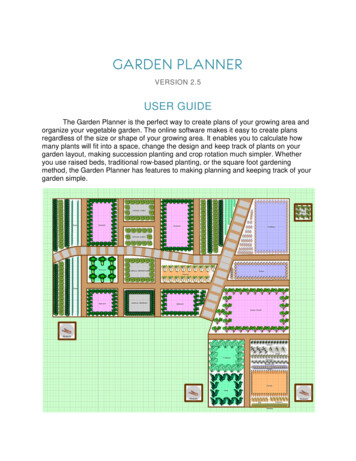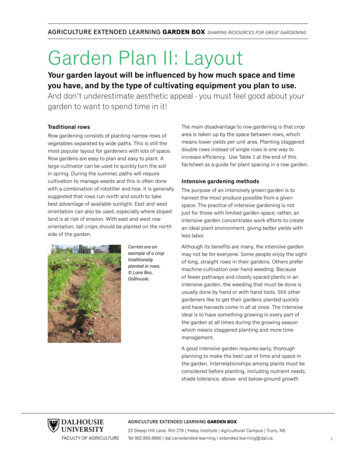
Transcription
AGRICULTURE EXTENDED LEARNING GARDEN BOXSHARING RESOURCES FOR GREAT GARDENINGGarden Plan II: LayoutYour garden layout will be influenced by how much space and timeyou have, and by the type of cultivating equipment you plan to use.And don’t underestimate aesthetic appeal - you must feel good about yourgarden to want to spend time in it!Traditional rowsRow gardening consists of planting narrow rows ofvegetables separated by wide paths. This is still themost popular layout for gardeners with lots of space.Row gardens are easy to plan and easy to plant. Alarge cultivator can be used to quickly turn the soilin spring. During the summer, paths will requirecultivation to manage weeds and this is often donewith a combination of rototiller and hoe. It is generallysuggested that rows run north and south to takebest advantage of available sunlight. East and westorientation can also be used, especially where slopedland is at risk of erosion. With east and west roworientation, tall crops should be planted on the northside of the garden.Carrots are anexample of a croptraditionallyplanted in rows. Lana Bos,Dalhousie.The main disadvantage to row gardening is that croparea is taken up by the space between rows, whichmeans lower yields per unit area. Planting staggereddouble rows instead of single rows is one way toincrease efficiency. Use Table 1 at the end of thisfactsheet as a guide for plant spacing in a row garden.Intensive gardening methodsThe purpose of an intensively grown garden is toharvest the most produce possible from a givenspace. The practice of intensive gardening is notjust for those with limited garden space; rather, anintensive garden concentrates work efforts to createan ideal plant environment, giving better yields withless labor.Although its benefits are many, the intensive gardenmay not be for everyone. Some people enjoy the sightof long, straight rows in their gardens. Others prefermachine cultivation over hand weeding. Becauseof fewer pathways and closely spaced plants in anintensive garden, the weeding that must be done isusually done by hand or with hand tools. Still othergardeners like to get their gardens planted quicklyand have harvests come in all at once. The intensiveideal is to have something growing in every part ofthe garden at all times during the growing seasonwhich means staggered planting and more timemanagement.A good intensive garden requires early, thoroughplanning to make the best use of time and space inthe garden. Interrelationships among plants must beconsidered before planting, including nutrient needs,shade tolerance, above- and below-ground growthAGRICULTURE EXTENDED LEARNING GARDEN BOX23 Sheep Hill Lane, Rm 276 Haley Institute Agricultural Campus Truro, NSTel 902.893.6666 dal.ca/extended-learning extended.learning@dal.ca1
patterns, and preferred growing season. However,using the techniques described below, anyone candevelop a high-yielding intensive garden.The raised bedThe raised bed or growing bed is the basic unit ofan intensive garden. A system of beds allows thegardener to concentrate soil preparation in smallareas, resulting in effective use of soil amendmentsand creating an ideal environment for vegetablegrowth. Beds are generally 90 to 120 cm (3-4’) wide(depending on the gardener’s reach) and as long asdesired. The gardener works from either side of thebed, reducing the incidence of compaction betweenplants caused by walking on the soil. Beds should runeast and west for best sun access. Tall crops shouldbe planted in beds on the north side of the garden.Soil preparation is the key to successful intensivegardening. To grow so close together, plantsmust have adequate nutrients and water. Fertilitymanagement and irrigation will help, but there is nosubstitute for deep, fertile soil high in organic matter.Humus-rich soil will hold extra nutrients, and existingelements that are “locked up” in the soil are releasedby the actions of earthworms, microorganisms,and acids present in a life-filled soil, making themavailable for plant use.Temporary raised bedsand composted sheepmanure were used toimprove drainage andsoil texture on thisheavy clay soil. R.Campbell, Dalhousie.generous amount of compost or manure, and returnthe mixture to the bed. It should be somewhat fluffyand may be raised slightly. To create a true raised bed,take topsoil from the neighboring pathways and mixit in as well.This is a lot of work! Try it in one or two beds for someof your most valuable plants; if you like the results,you can proceed to other beds when you have time.One nice thing about raised bed gardening is that itbreaks work into units. Instead of gazing desperatelyat a garden full of weeds, thinking you’ll never havetime to clean it up, you can look at each bed and say,“I can do that in half an hour today!” Other choresare accomplished with the same ease. Raised bedgardening also provides design opportunities such ascreating a pattern of raised beds through the garden.By their nature, raised beds are a form of widebed gardening, a technique in which seeds andtransplants are planted in wide bands of several rowsor broadcast in a wide strip. In general, the goal is tospace plants at equal distances from each other on allsides, so that leaves will touch at maturity. This savesspace, and the close plantings reduce moisture lossfrom surrounding soil.Temporary raised beds and composted sheep manure wereused to improve drainage and soil texture on this heavy claysoil. R. Campbell, Dalhousie.Vertical gardeningIf your soil is not deep, double-dig the beds for bestresults. Remove the top 30 cm (12”) of soil from thebed. Insert a spade or spading fork into the next 25to 30 cm (10-12”) of soil, and wiggle the handle backand forth to break up compacted layers. Do this every15 to 20 cm (6-8”) in the bed. Mix the topsoil with aThe use of trellises, nets, strings, cages, or polesto support growing plants constitutes verticalgardening. This technique is especially suited, butnot limited, to gardeners with a small garden space.Vining and sprawling plants, such as cucumbers,tomatoes, melons, and pole beans, are obviousAGRICULTURE EXTENDED LEARNING GARDEN BOX23 Sheep Hill Lane, Rm 276 Haley Institute Agricultural Campus Truro, NSTel 902.893.6666 dal.ca/extended-learning extended.learning@dal.ca2
candidates for this type of gardening. Some plantsentwine themselves onto the support, while othersmay need to be tied. Remember that a verticalplanting will cast a shadow, so beware of shading sunloving crops, or else take advantage of the shade byplanting shade-tolerant crops near the vertical ones.Plants grown vertically take up much less space onthe ground, and although the yield per plant maybe (but is not always) lower, the yield per squaremeter (square foot) of garden space is much greater.Because vertically growing plants are more exposed,they dry out faster and may need to be watered morefrequently than if they were allowed to spread overthe ground. This fast drying is also an advantageto those plants susceptible to fungus diseases. Ahigher rate of fertilization may be needed, and soilshould be deep and well-drained to allow roots toextend vertically rather than compete with others at ashallow level.A simple arched trellisadds extra space andmakes an attractiveentrance to thiscommunity garden. Lana Bos,Dalhousie.A structure like thispergola can addvertical space to thegarden, but requiretime and money toconstruct. R. Campbell,Dalhousie.InterplantingGrowing two or more types of vegetables in the sameplace at the same time is known as interplanting.Proper planning is essential to obtain high productionand increased quality of the crops planted. Thistechnique has been practiced for thousands of yearsand is gaining widespread support in this country. Forexample, carrots and radish are commonly plantedtogether in the same row. The fast growing radishacts as a nurse crop, and they are harvested longbefore the carrots reach maturity.To successfully plan an interplanted garden, thefollowing factors must be taken into account foreach plant: length of the plant’s growth period; itsgrowth pattern (tall, short, below or above ground);possible negative effects on other plants (such asthe allelopathic effects of sunflowers and Jerusalemartichokes on nearby plants); preferred season;and light, nutrient, and moisture requirements.Interplanting can be accomplished by alternatingrows within a bed (plant a row of peppers next to arow of onions), by mixing plants within a row, or bydistributing various species throughout the bed. Forthe beginner, alternating rows may be the easiest tomanage at first.Long-season (slow to mature) and short-season(quick to mature) plants like carrots and radishes,respectively, can be planted at the same time. Theradishes are harvested before they begin to crowdthe carrots. An example of combining growth patternsis planting smaller plants close to larger plants(e.g. radishes at the base of beans or broccoli).Shade tolerant species, like lettuce, spinach, andcelery, may be planted in the shadow of taller crops.Heavy feeders, such as cabbage family crops,should be interplanted with less gluttonous plants.Interplanting can help keep insect and diseaseproblems under control. Pests are usually fairlycrop-specific: that is, they prefer vegetables of onetype or family. Mixing families of plants helps tobreak up large expanses of the pest-preferred crop,helping to contain early pest damage within a smallarea, thus giving the gardener a little more time todeal with the problem. One disadvantage is thatwhen it does come time to spray for pests, it’s hardto be sure that all plants are protected.AGRICULTURE EXTENDED LEARNING GARDEN BOX23 Sheep Hill Lane, Rm 276 Haley Institute Agricultural Campus Truro, NSTel 902.893.6666 dal.ca/extended-learning extended.learning@dal.ca3
Intensive garden plant spacingIndividual plants are closely spaced in a raised bedor interplanted garden. Also, an equidistant spacingpattern calls for plants to be the same distance fromeach other within the bed: that is, plant so that thecenter of one plant is the same distance from plantson all sides of it. In beds of more than two rows, thismeans that the rows should be staggered so thatplants in every other row are between the plants inadjacent rows.The distance recommended for plants within the rowon a seed packet is the distance from the centre ofone plant to the centre of the next. This results in anefficient use of space and leaves less area to weedand mulch. The close spacing tends to create a nearlysolid leaf canopy, acting as a living mulch, decreasingwater loss, and keeping down weed problems.However, plants should not be crowded to the pointthat disease problems arise or competition causesstunting.intervals for a continuous harvest. This requiressome care, though, because crops planted veryearly are likely to get a slower start because of lowtemperatures. In the case of corn, it can be disastrousto have two cultivars pollinating at the same time, asthe quality of the kernels may be affected. Give earlyplanted corn extra time to get started, for best results.Another way to achieve the same result is to plant,at once, various cultivars of the same vegetable; forexample, you can plant an early-season, a mid-season,and a late-season corn at the same time and have alengthy harvest.Starting seeds indoors for transplanting is animportant aspect of intensive gardening. To get themost from the garden plot, a new crop should beready to take the place of the crop being removed.Several weeks may be gained by having 15 cm (6”)transplants (4 to 6 leaf stage for cole crops) ready togo into vacated areas. Remember to recondition thesoil for the new plants.To make the most ofsuccession planting, a new crop oftransplants shouldbe ready to take theplace of the crop beingremoved. DesireeJans, DalhousieThe use of pots orhanging baskets issimple way to optimizethe use of a smallgarden space. Lana Bos,Dalhousie.Planning the intensive gardenSuccession and relay plantingSuccession planting is an excellent way to make themost of an intensive garden. To obtain a successionof crops, plant something new in spots vacated byspent plants. Corn after peas is a type of succession.Planting a spring, summer, and fall garden is anotherform of succession planting. Cool-season crops(broccoli, lettuce, pea) are followed by warm-seasoncrops (bean, tomato, pepper), and where possible,these may be followed by more cool-season plants oreven a winter cover crop.Good gardening practices, such as watering,fertilizing, crop rotation, composting, and sanitation,are especially important in an intensive garden. Anintensive garden requires more-detailed planning,but the time saved in working the garden and theincreased yields make it well worthwhile. Start yourplanning with Table 2 as a guide to plant spacing andremember to check the factsheet on ‘Crop rotationand companion planting’ on this web site to seewhich plants make good neighbors. Have fun!Relaying is another common practice, consisting ofoverlapping plantings of one type of crop. The newplanting is made before the old one is removed. Forinstance, sweet corn may be planted at two-weekIn this garden rockshave been used tocreate a simple raisedbed for tomatoes. Sarah Macdonald,Dalhousie.AGRICULTURE EXTENDED LEARNING GARDEN BOX23 Sheep Hill Lane, Rm 276 Haley Institute Agricultural Campus Truro, NSTel 902.893.6666 dal.ca/extended-learning extended.learning@dal.ca4
TABLE 1. TRADITIONAL ROW GARDEN SPACING GUIDECropPlanting distance in rowPlanting distance between rowscminchcminchAsparagus451890-15036-59Beans, bush5-7.52-360-7524-30Beans, Lima7.5-103-460-9024-36Beans, pole10-304-1290-12036-48Beans, 015-2460-9024-36Brussels 0-36Cabbage, 4-2469-9027-36Chard, 630-7512-30Lettuce, Bib15-256-1035-6014-24Lettuce, ion eas, 3-638-7515-30Squash, summer60-9024-3690-15036-59Squash, winter90-21036-8290-30036-118Sweet 118AGRICULTURE EXTENDED LEARNING GARDEN BOX23 Sheep Hill Lane, Rm 276 Haley Institute Agricultural Campus Truro, NSTel 902.893.6666 dal.ca/extended-learning extended.learning@dal.ca5
TABLE 2. INTENSIVE GARDEN SPACING GUIDECropcminchAsparagus38-4515-18Beans, bush10-154-6Beans, Lima10-154-6Beans, s sprouts38-4515-18Cabbage38-4515-18Cabbage, 18Chard, hlrabi15-256-10Leeks7.5-153-6Lettuce head25-3010-12Lettuce, 6Spinach10-154-6Squash, summer45-6018-24Squash, winter60-9024-36Sweet : To determine spacing for interplanting, add the centimeter(or inch) for the two crops to be planted together, and divide thesum by 2. For example, if radishes are planted next to beans,add 5 cm 10 cm 15 cm, then divide 15 cm by 2 7.5 cm. Theradishes should be planted 7.5 cm (3”) from the beans.AGRICULTURE EXTENDED LEARNING GARDEN BOX23 Sheep Hill Lane, Rm 276 Haley Institute Agricultural Campus Truro, NSTel 902.893.6666 dal.ca/extended-learning extended.learning@dal.ca6
Activity 1Draw a plan of your garden layout.Use graph paper marked to the appropriate scale and draw the outline of your garden. Mark which direction isnorth. Add permanent features like pathways, trees, bushes and long-lived perennials.Using information from ‘Garden Plan I: What to grow and how much’, make a list of the vegetables you want togrow and how many of each you will need. Next, figure out how much space each vegetable crop will take up.Lastly, note each crop’s nutrient requirements (heavy, moderate, or light).Arrange the vegetables on your graph paper, trying to group those with similar nutrient requirements. Makesure tall crops are not shading others. Keep in mind how you might rotate your crops from year to year.Activity 2Make garden signs.Garden signs might be used to designate individual mini-gardens within a community garden or to identifyspecific vegetables within a bed. Either way, they are a fun addition to the vegetable garden!Garden signs can be very simple. For small signs, start with any non-toxic material that is resistant to weather:small cedar shingles, strips of plastic cut from milk containers, or even old utensils. Use a permanent marker towrite vegetable names and stick them into the soil.Fancier signs can be made out of wood or large rocks. Use water-proof paints or, if gluing pictures onto wood,cover your creation with polyurethane.AGRICULTURE EXTENDED LEARNING GARDEN BOX23 Sheep Hill Lane, Rm 276 Haley Institute Agricultural Campus Truro, NSTel 902.893.6666 dal.ca/extended-learning extended.learning@dal.ca7
Activity 3Build a trellis or teepeeTo build a trellis, you will need two upright poles about 8 feet long and sharpened to a point at one end.(A 2x4 ripped lengthwise will yield a good pair of 2x2 uprights.) Drive the uprights into the ground5 to 10 feet apart, leaving about 6 feet above ground. Use an iron bar to make a starter hole, especiallyin heavy soils. A crossbar sits on the uprights. Weave the crossbar through alternate holes in the top edgeof 6 foot tall nylon or plastic netting. Place the crossbar on top of the uprights and screw into place.Anchor the bottom of the netting into the soil using garden stakes (1 inch square by 12 inches long) witha slight notch cut into the edge. For tomatoes and pole beans, use untreated garden twine instead of netting.Tie the twine to the crossbar and anchor to a garden stake.To build a teepee, gather 3 to 6 poles 10 to 12 feet long and sharpen to a point at one end. Sink the polesone to two feet into the ground. Pull the poles into a tight bundle at the top and use strong twine to lashthem together. For additional support, run some more twine around the poles in a criss-cross patternor attach netting. Plant seeds of climbing plants on the outside of the poles. You might also like to leaveone section between the poles unplanted. This creates a doorway into the teepee and a great place forkids (or grownups) to hideout!AGRICULTURE EXTENDED LEARNING GARDEN BOX23 Sheep Hill Lane, Rm 276 Haley Institute Agricultural Campus Truro, NSTel 902.893.6666 dal.ca/extended-learning extended.learning@dal.ca8
Garden Plan II: Layout Your garden layout will be influenced by how much space and time you have, and by the type of cultivating equipment you plan to use. And don't underestimate aesthetic appeal - you must feel good about your garden to want to spend time in it! Traditional rows Row gardening consists of planting narrow rows of





